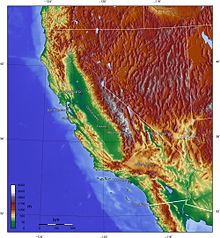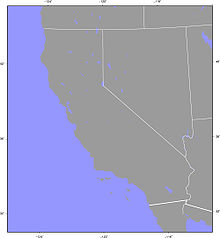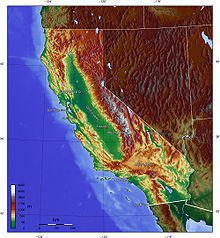User:Captain Blood~enwiki/GMT Example



How to create a topographic map with GMT
[edit]Here is described how one can create a map of California.
Installation
[edit]Install the Generic Mapping Tools (must use Version 4.X+), Linux is preferred (Windows is possible too, but I don't know about that (NOTE: Tested in Windows. Use the script in a Cygwin shell (to eliminate rewrite))). Either way Ghostscript or other PostScript software is needed too. Read GMT's tutorial [1]. Especially sections 4.1.3, 4.1.4 (how to create simple maps) and 4.3 (using grid files for the relief). Anyway, be aware GMT is a set of command line tools, there is no GUI. There exists a GUI frontend for GMT, see the external link in Generic Mapping Tools but I haven't tried that.
Topographic data
[edit]Download e10g.tgz from http://www.ngdc.noaa.gov/mgg/topo/gltiles.html and untar it into GMTHOME/GMT4.0/share/dbase
If you want bathymetry (oceanic topography), download etopo2.grd from http://rda.ucar.edu/datasets/ds759.3/ (registration required, free). It is already in GMT's grd-format.
NOTE:Despite the similarity of names, the etopo2.grd file covers the entire world, while e10g only covers a western portion of North America.
Gridfiles
[edit]Add the following lines into GMTHOME/GMT4.0/share/dbase/grdraster.info (we need line 5 only now, but the other may become useful)
1 "GLOBE_G" "m" -R-180/-90/50/90 -I0.5m P i 1 0 -500 a10g 2 "GLOBE_G" "m" -R-90/0/50/90 -I0.5m P i 1 0 -500 b10g 3 "GLOBE_G" "m" -R0/90/50/90 -I0.5m P i 1 0 -500 c10g 4 "GLOBE_G" "m" -R90/180/50/90 -I0.5m P i 1 0 -500 d10g 5 "GLOBE_G" "m" -R-180/-90/0/50 -I0.5m P i 1 0 -500 e10g 6 "GLOBE_G" "m" -R-90/0/0/50 -I0.5m P i 1 0 -500 f10g 7 "GLOBE_G" "m" -R0/90/0/50 -I0.5m P i 1 0 -500 g10g 8 "GLOBE_G" "m" -R90/180/0/50 -I0.5m P i 1 0 -500 h10g 9 "GLOBE_G" "m" -R-180/-90/-50/0 -I0.5m P i 1 0 -500 i10g 10 "GLOBE_G" "m" -R-90/0/-50/0 -I0.5m P i 1 0 -500 j10g 11 "GLOBE_G" "m" -R0/90/-50/0 -I0.5m P i 1 0 -500 k10g 12 "GLOBE_G" "m" -R90/180/-50/0 -I0.5m P i 1 0 -500 l10g 13 "GLOBE_G" "m" -R-180/-90/-90/-50 -I0.5m P i 1 0 -500 m10g 14 "GLOBE_G" "m" -R-90/0/-90/-50 -I0.5m P i 1 0 -500 n10g 15 "GLOBE_G" "m" -R0/90/-90/-50 -I0.5m P i 1 0 -500 o10g 16 "GLOBE_G" "m" -R90/180/-90/-50 -I0.5m P i 1 0 -500 p10g
NOTE: Although this article was originally written with blank lines between some of the text lines (ex. lines 4 and 5, lines 8 and 9), the grdraster.info file MUST NOT have blank lines before, in between, or after the lines with text. Otherwise, you will receive an error "ERROR reading grdraster.info file." "File number conversion error."
FURTHER NOTE: At least in Windows, there must be a carriage return/line feed (CRLF) at the end of the last line or the p10g file will not be processed.
Create the gridfile e.grd (from anywhere) (see GMT tutorial chapter 4.3):
grdraster 5 -R-180/-90/0/50 -Ge.grd
Create the illuminated gridfile e_i5.grd:
grdgradient e.grd -Ne.5 -A100 -M -Ge_i5.grd
Labels
[edit]The following textfiles contain some labels and coordinates:
# file california_capital -121:29 38:34 10 0 0 BR SACRAMENTO
# file california_cities -118:14 34:03 10 0 0 TR Los Angeles -122:25 37:46 10 0 0 TR San Francisco -121:53 37:20 10 0 0 TR San Jose -119:46 36:44 10 0 0 BR Fresno -117:09 32:42 10 0 0 TR San Diego
# file california_cross -117:00 36:30 10 0 2 TL Death Valley
# file california_labels 12 15 10 -55 2 MC Sierra Nevada 10 14 10 -50 2 MC Central Valley 16 8 10 0 2 MC Mojave Desert
# file california_peaks -118:17:31 36:34:43 10 0 2 TR Mount Whitney
Color palettes
[edit]The color palette for the topography:
# file usa.cpt #COLOR_MODEL = RGB # 0 0 97 71 50 16 122 47 50 16 122 47 500 232 215 125 500 232 215 125 1200 161 67 0 1200 161 67 0 1700 130 30 30 1700 130 30 30 2800 110 110 110 2800 110 110 110 4000 255 255 255 4000 255 255 255 6000 255 255 255 N 0 97 71 F 255 0 0 B 0 97 71
The color palette for the bathymetry (optional)
# file meer.cpt
#COLOR_MODEL = RGB
#
-11000 36 38 175 -5500 56 58 195
-5500 56 58 195 -3000 70 72 214
-3000 70 72 214 -2000 81 102 217
-2000 81 102 217 -750 100 129 223
-750 100 129 223 -70 131 161 230
-70 131 161 230 -20 164 192 240
-20 164 192 240 0 170 200 255
N 170 200 255
F 170 200 255
B 170 200 255
The Map
[edit]Not the final step, but the most important: run the following shell script:
#!/bin/bash
FILE=california
AREA=-R-126/31/-112/43r
PROJ=-JB-120.5/37/33/41/24c
DETAIL=-Dh
GRID=4
SCALE=-Lf-123/31.55/37/200k
NATION1=-N1/8/255/255/255
NATION2=-N2/3/255/255/255
LAND=-G155/155/155
WATER=-S150/150/255
COAST=-W2/40/40/120
RIVERS="-Ia/1/40/40/120 -I1/4/40/40/120 -I2/2/40/40/120"
ALL="-P $AREA $PROJ"
TOPO=e.grd
ILLU=-Ie_i5.grd
PALETTE=-Cusa.cpt
TOPO2=etopo2.grd
PALETTE2=-Cmeer.cpt
# TOPO ########################################################################
# bathymetry
grdimage $TOPO2 $PALETTE2 $ALL -K >temp.ps
# clippath for land
pscoast $ALL $DETAIL -Gc -K -O >>temp.ps
# land
grdimage $TOPO $ILLU $PALETTE $ALL -K -O >>temp.ps
# clear clippath
pscoast -R -J -O -K -Q >>temp.ps
cp temp.ps topo.ps
# coast, rivers
pscoast $ALL $DETAIL -B"$GRID"g"$GRID" $COAST $RIVERS $NATION1 $NATION2 \
$SCALE -O -K >>topo.ps
psscale -D.4c/3.0c/2i/.2i $PALETTE -B:m: -L -P -O -K >>topo.ps
# NATION ######################################################################
pscoast $ALL $LAND $WATER $DETAIL $LAND $NATION1 $NATION2 -B"$GRID"g0 \
>nation.ps
# LABELS ######################################################################
function do_text ()
# $1: Koordinaten-Datei
# $2: Textfarbe ("-G0/0/0 -W178/93/155")
# $3: Symbol+Farbe ("-Sc.045 -G255/0/0 -W")
# $4: ps Datei
{
# echo "do_text($*)"
# BL/BR/TR/TL rausfiltern, Labels drucken
grep BL $1 | pstext $ALL $2 -D.07/.07 -O -K >>$4
grep BR $1 | pstext $ALL $2 -D-.14/.07 -O -K >>$4
grep TR $1 | pstext $ALL $2 -D-.14/-.04 -O -K >>$4
grep TL $1 | pstext $ALL $2 -D.07/-.04 -O -K >>$4
grep BC $1 | pstext $ALL $2 -D0.0/.07 -O -K >>$4
grep TC $1 | pstext $ALL $2 -D0.0/-.07 -O -K >>$4
# Symbole drucken
psxy $1 $ALL $3 -O -K >>$4
}
TF=topo.ps
TEXTF="-G255/255/255 -S4/0/0/0"
SYMBF="-G255/0/0 -W2/0/0/0"
do_text "$FILE"_cities "$TEXTF" "-Ss.2 $SYMBF" $TF
do_text "$FILE"_capital "$TEXTF" "-Sa.3 $SYMBF" $TF
do_text "$FILE"_peaks "$TEXTF" "-St.25 -W3/0/0/0" $TF
do_text "$FILE"_cross "$TEXTF" "-Sx.25 -W3/0/0/0" $TF
# GRID2=-B1g1
pstext "$FILE"_labels $GRID2 -JX24c/27c -R0/24/0/27 $TEXTF -O >>$TF
This will create the PostScript files topo.ps and nation.ps.
The final map
[edit]Open topo.ps and nation.ps with GIMP (300 Dpi), topo.ps with anti-aliasing, nation.ps without. Crop them. Add a layer to topo.ps, copy nation.ps into the new layer, fill all gray areas with black, remove everything else, put the transparency of the new layer at 40%. All land is darker now. Mark california with the color selection tool and cut it. It is bright now. Scale down to 1400 pixels. That's all!
